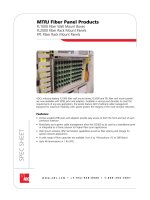Tài liệu Chapter 14 Wireless LANs pptx
Bạn đang xem bản rút gọn của tài liệu. Xem và tải ngay bản đầy đủ của tài liệu tại đây (924.47 KB, 34 trang )
14.1
Chapter 14
Wireless LANs
Copyright © The McGraw-Hill Companies, Inc. Permission required for reproduction or display.
14.2
14-1 IEEE 802.11
14-1 IEEE 802.11
IEEE has defined the specifications for a wireless
IEEE has defined the specifications for a wireless
LAN, called IEEE 802.11, which covers the physical
LAN, called IEEE 802.11, which covers the physical
and data link layers.
and data link layers.
Architecture
MAC Sublayer
Physical Layer
Topics discussed in this section:
Topics discussed in this section:
14.3
A BSS without an AP is called an ad hoc
network;
a BSS with an AP is called an
infrastructure network.
Note
14.4
Figure 14.1 Basic service sets (BSSs)
14.5
Figure 14.2 Extended service sets (ESSs)
14.6
Figure 14.3 MAC layers in IEEE 802.11 standard
14.7
Figure 14.4 CSMA/CA flowchart
14.8
Figure 14.5 CSMA/CA and NAV
14.9
Figure 14.6 Example of repetition interval
14.10
Figure 14.7 Frame format
14.11
Table 14.1 Subfields in FC field
14.12
Figure 14.8 Control frames
14.13
Table 14.2 Values of subfields in control frames
14.14
Table 14.3 Addresses
14.15
Figure 14.9 Addressing mechanisms
14.16
Figure 14.10 Hidden station problem
14.17
The CTS frame in CSMA/CA handshake
can prevent collision from
a hidden station.
Note
14.18
Figure 14.11 Use of handshaking to prevent hidden station problem
14.19
Figure 14.12 Exposed station problem
14.20
Figure 14.13 Use of handshaking in exposed station problem
14.21
Table 14.4 Physical layers
14.22
Figure 14.14 Industrial, scientific, and medical (ISM) band
14.23
Figure 14.15 Physical layer of IEEE 802.11 FHSS
14.24
Figure 14.16 Physical layer of IEEE 802.11 DSSS
14.25
Figure 14.17 Physical layer of IEEE 802.11 infrared









